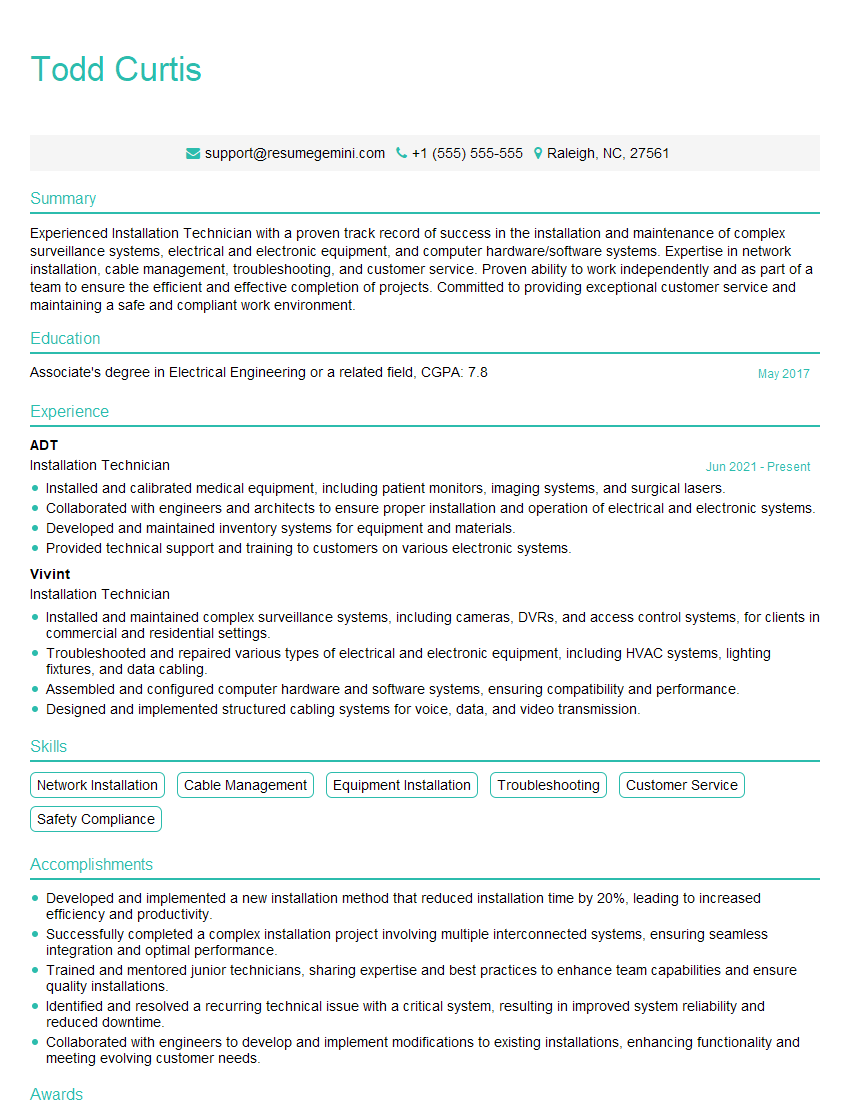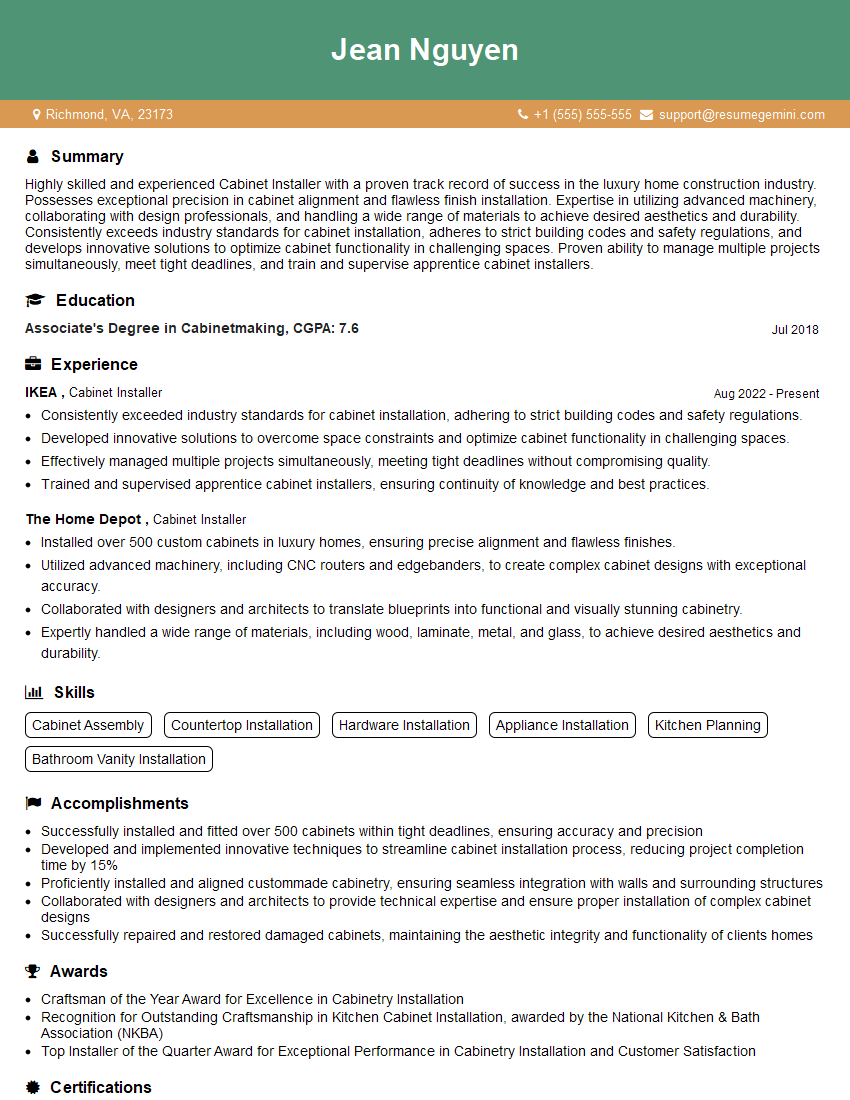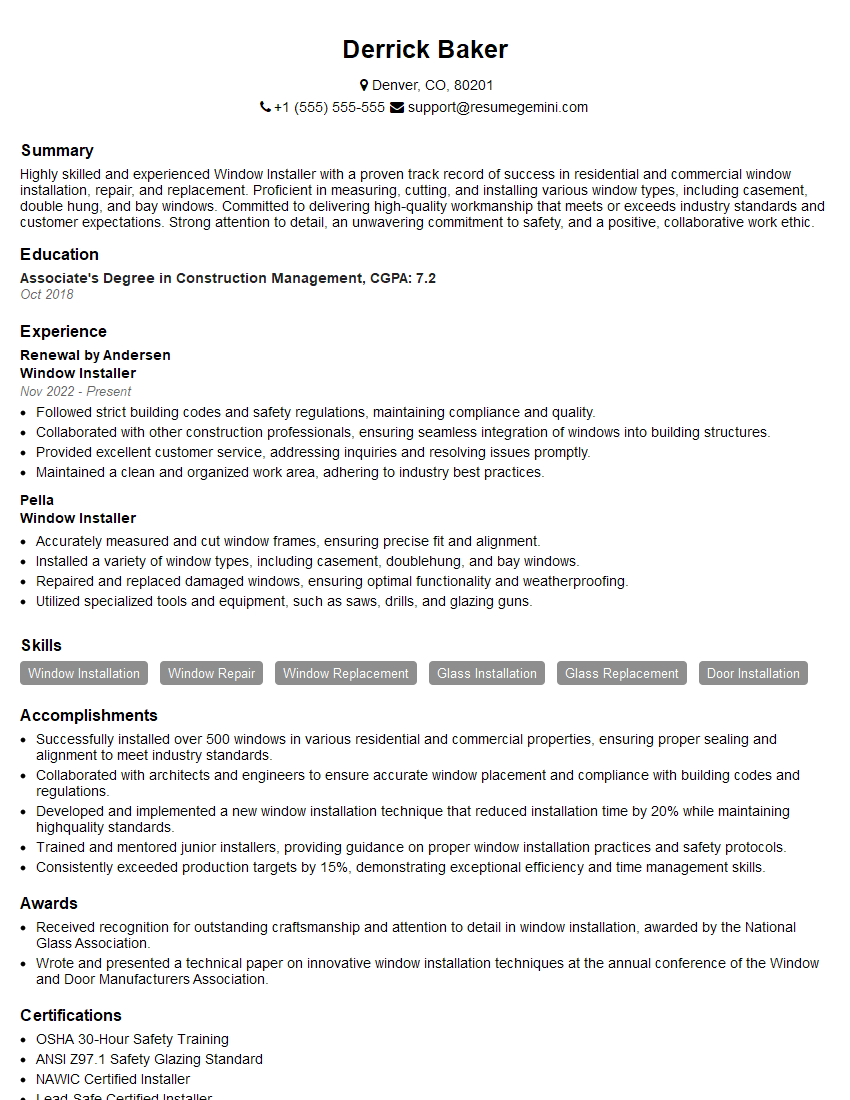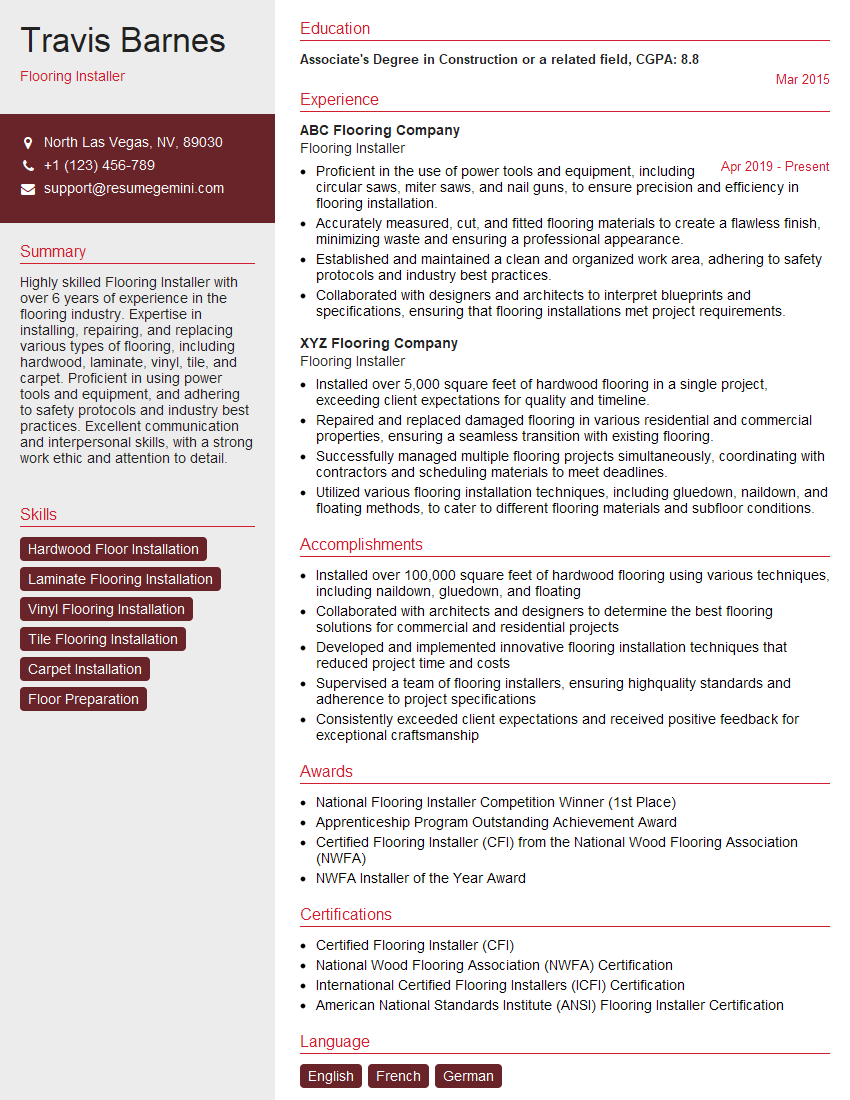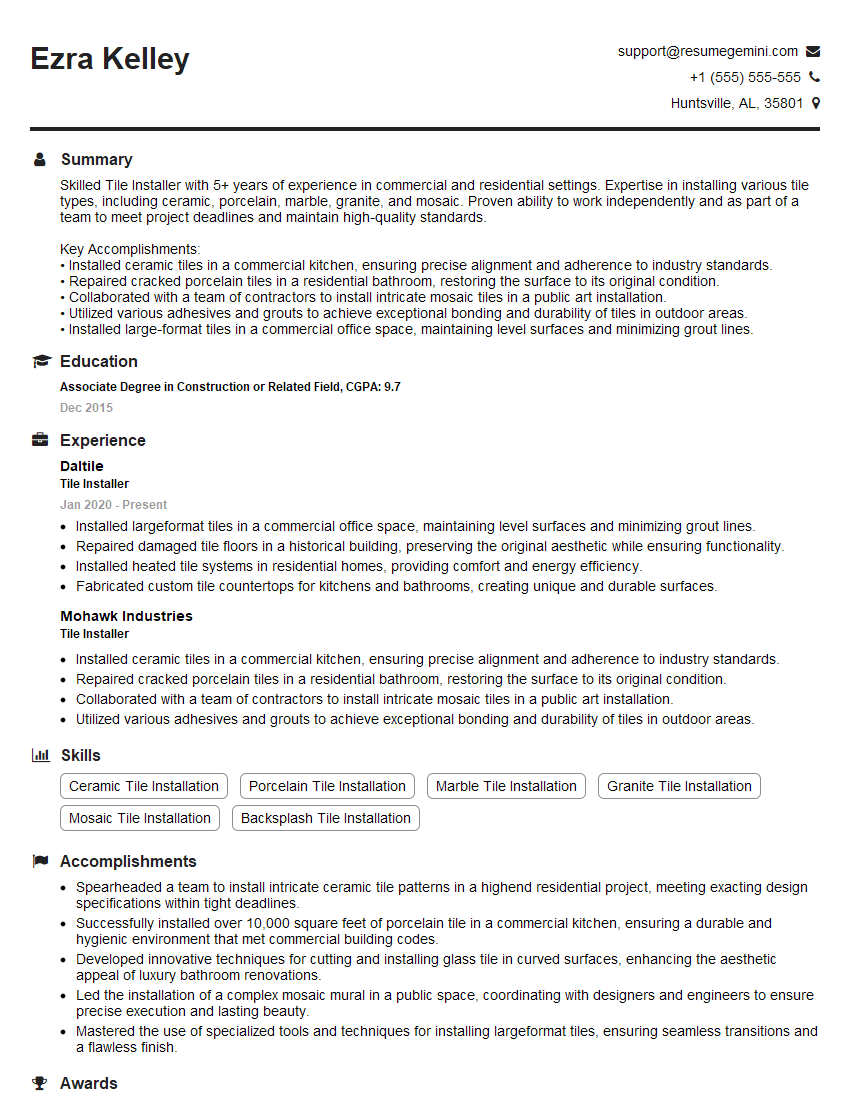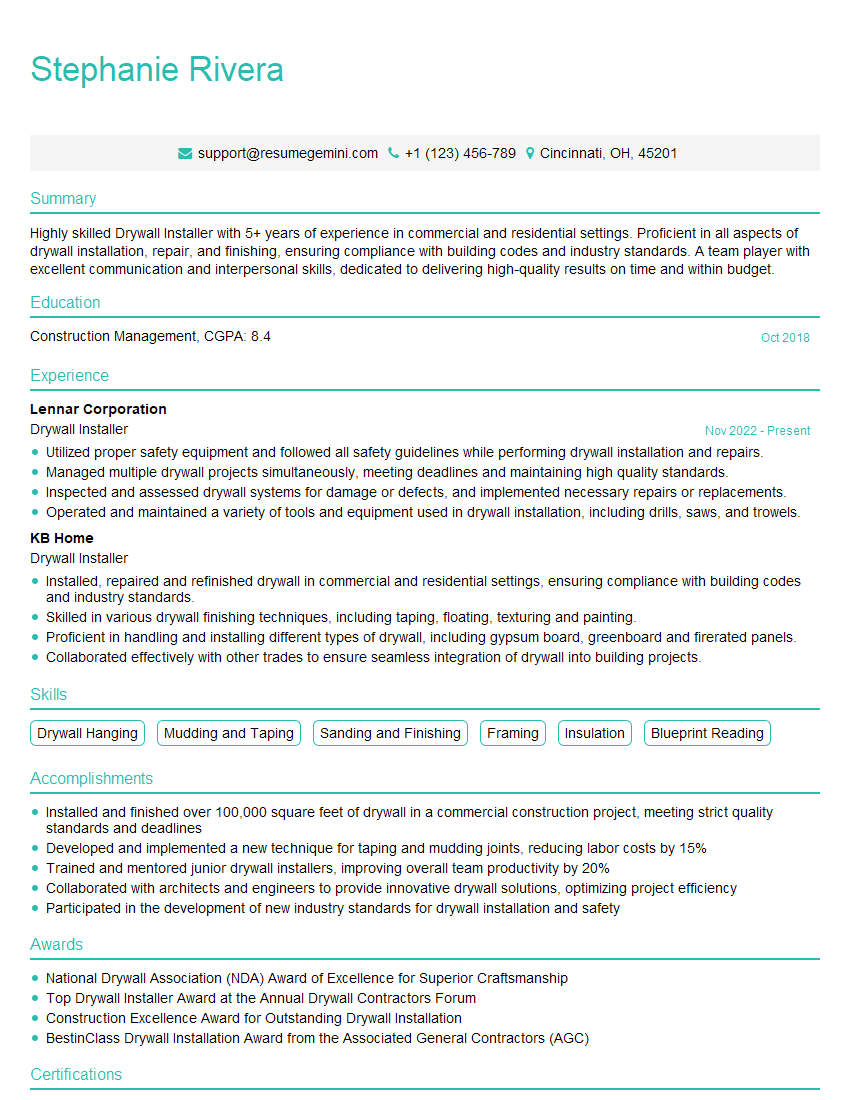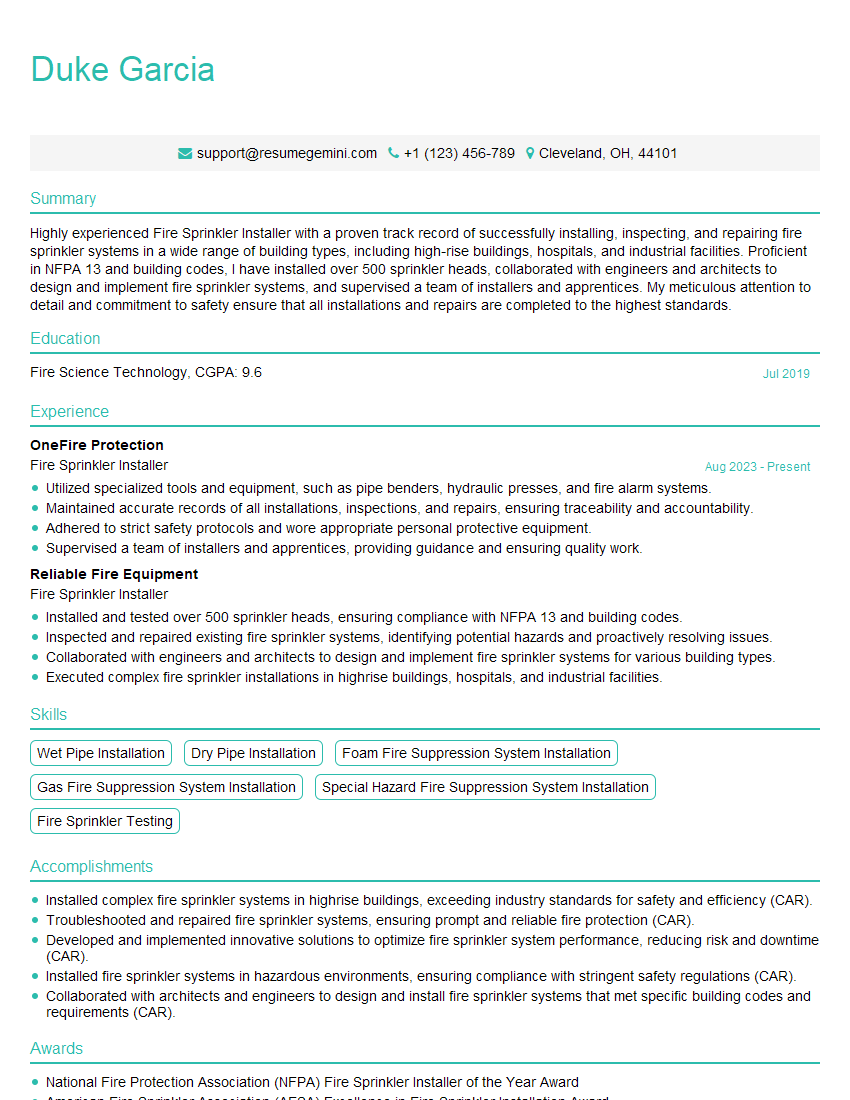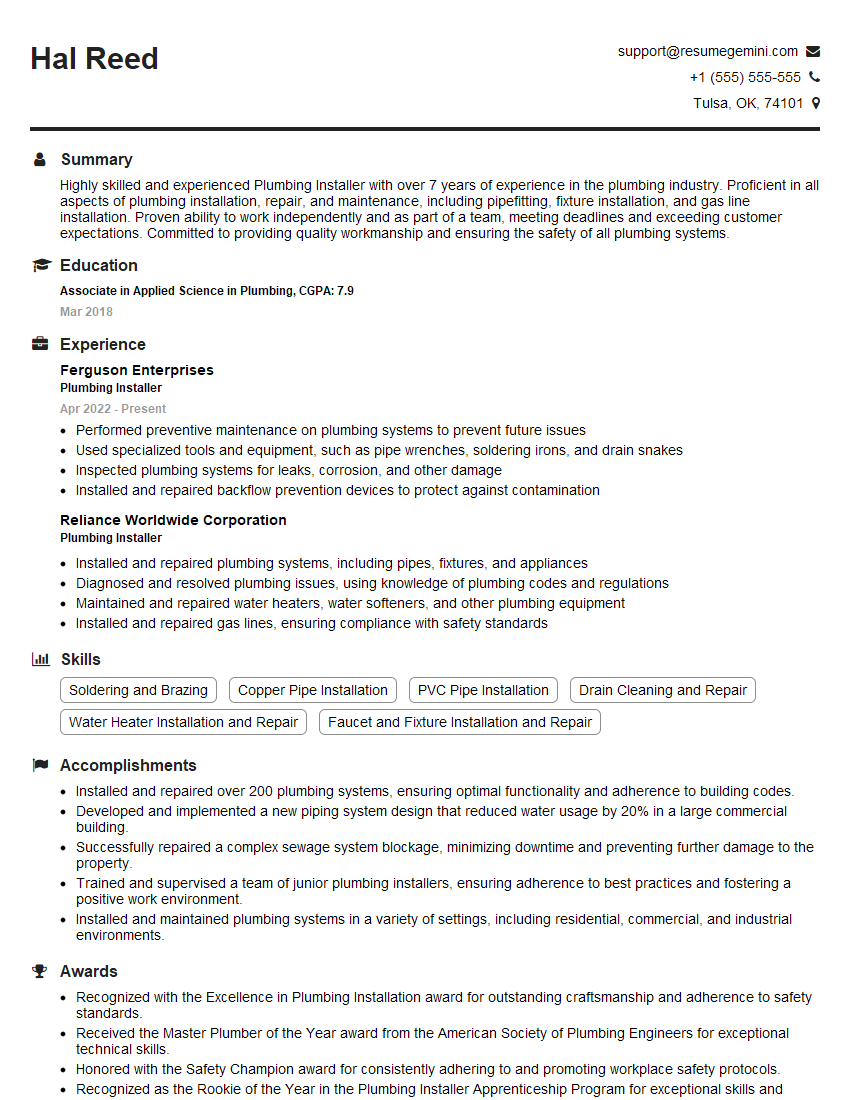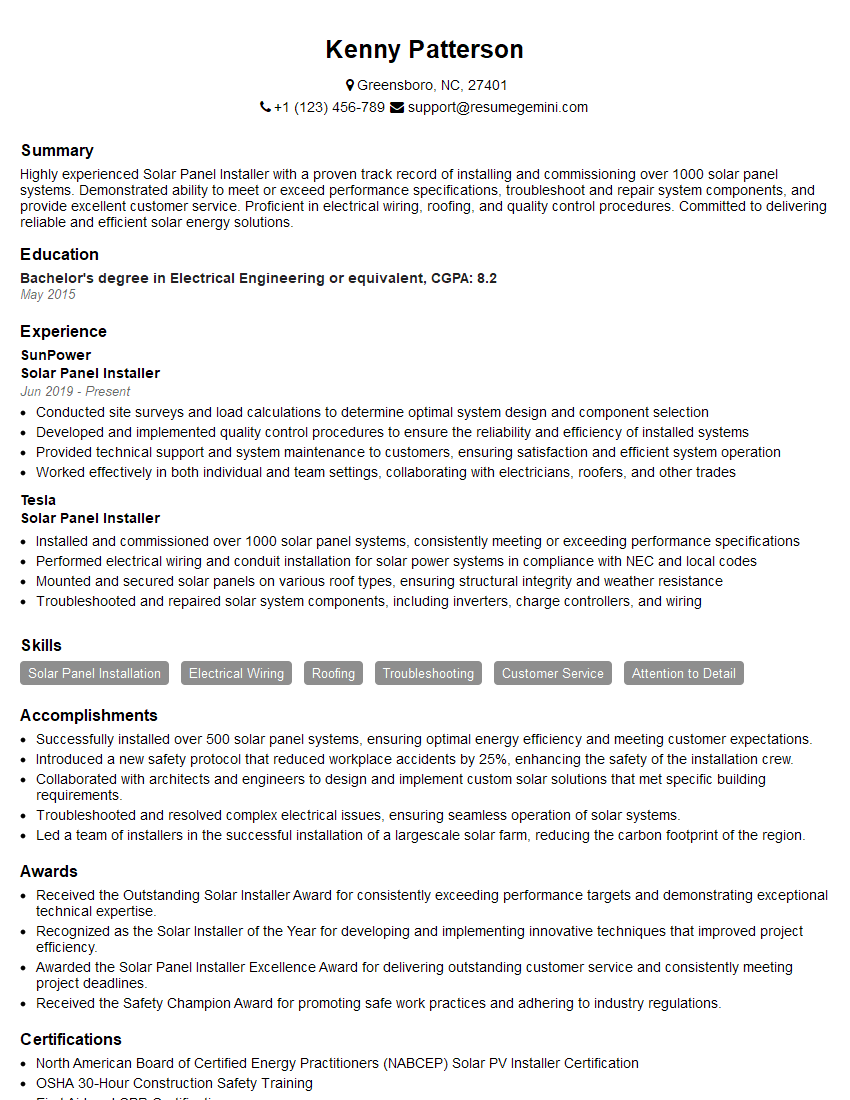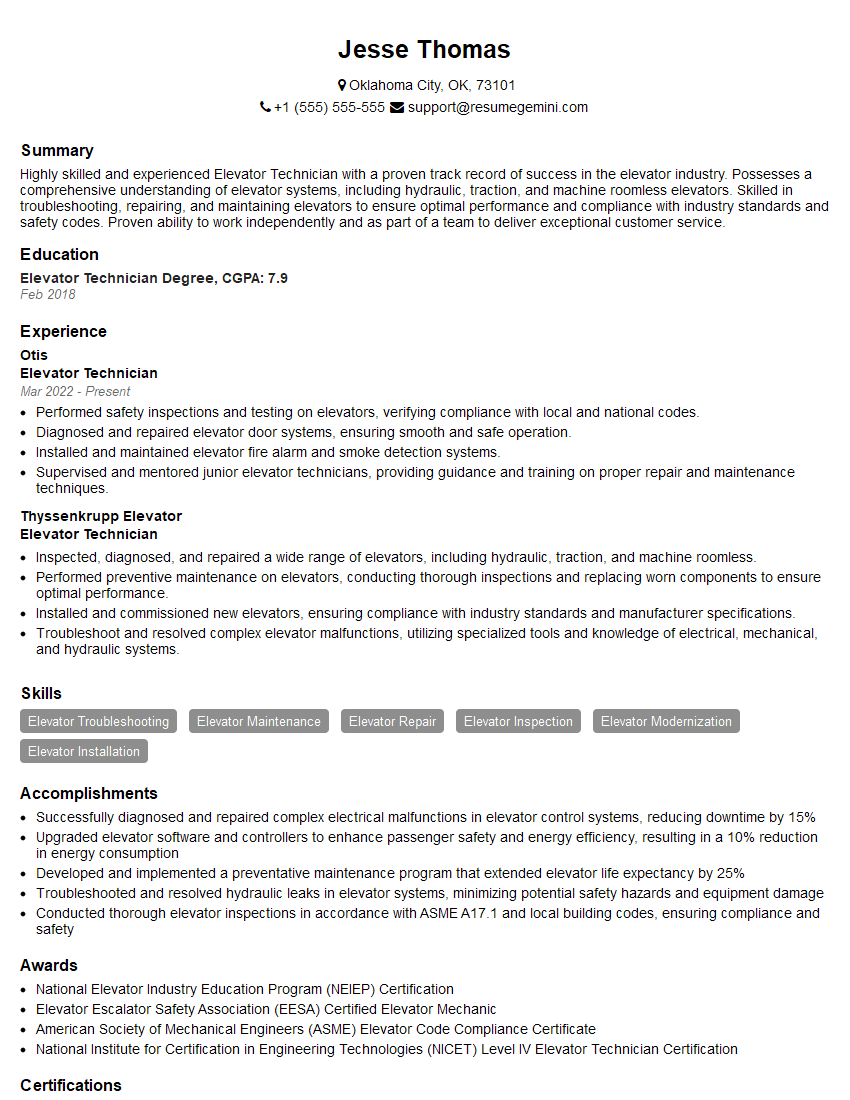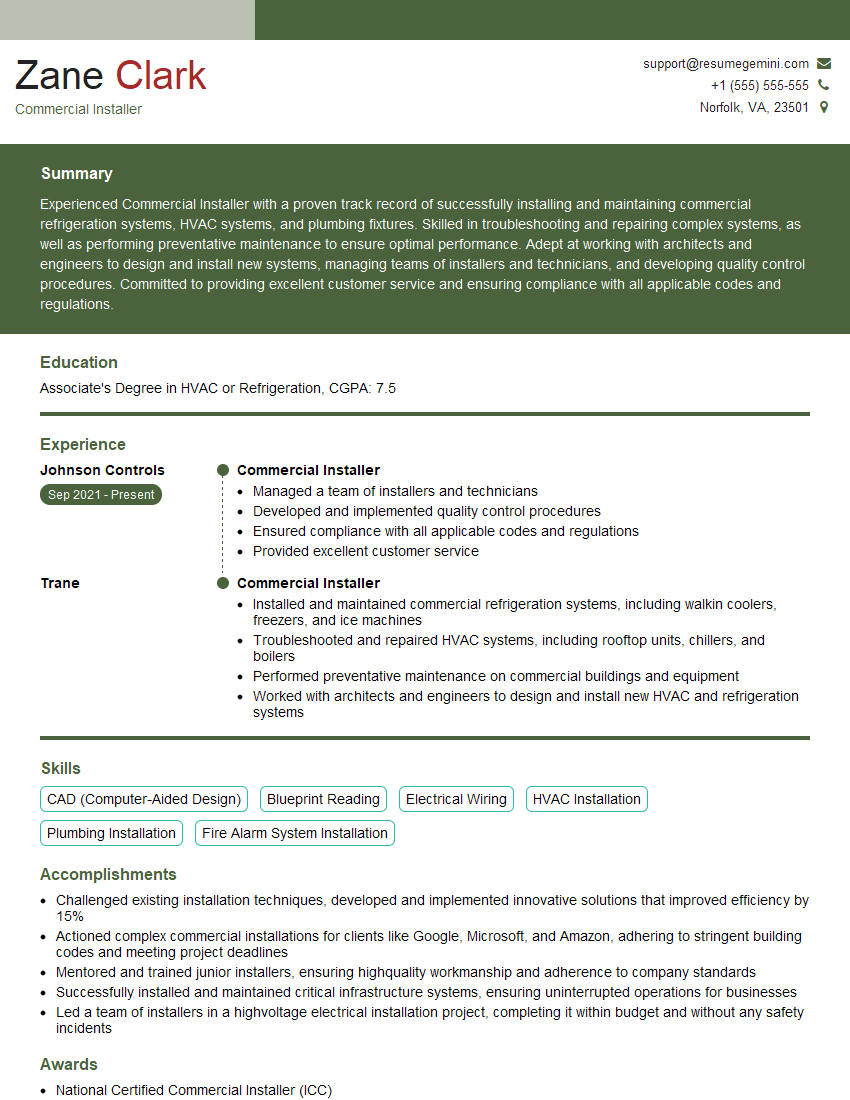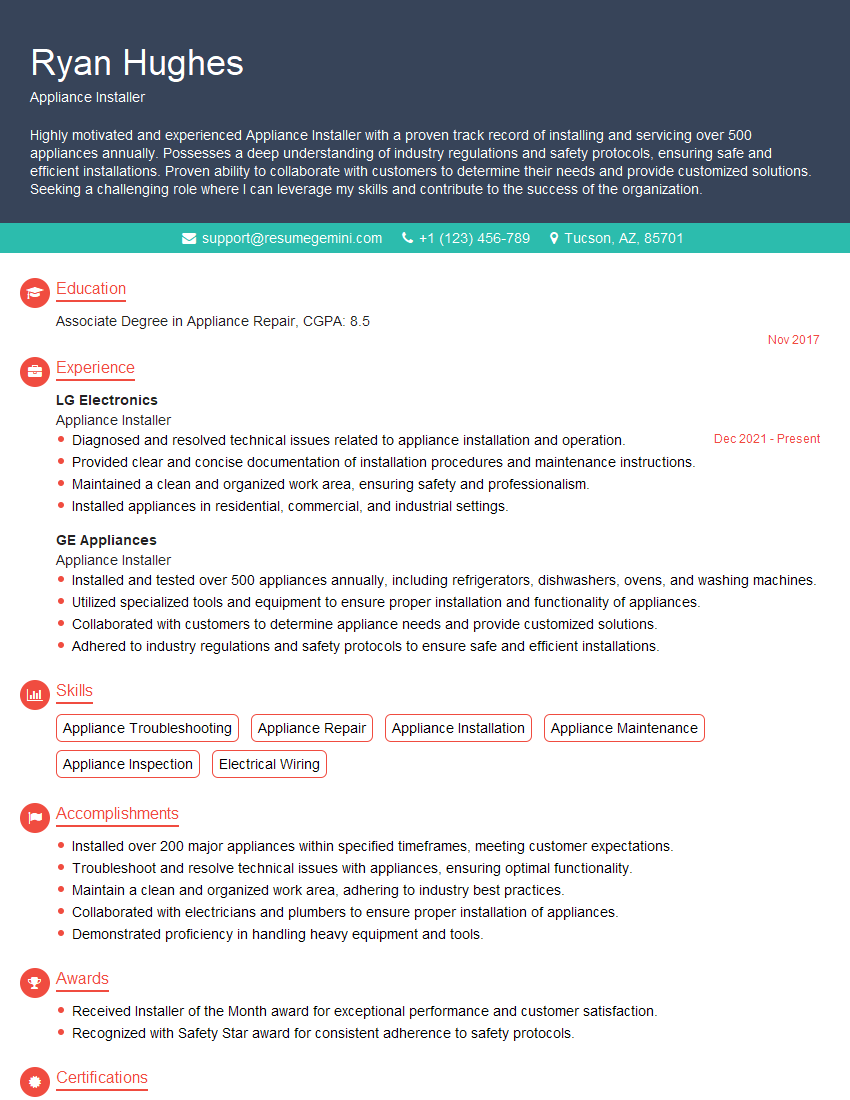Are you ready to stand out in your next interview? Understanding and preparing for Commercial and Residential Installation interview questions is a game-changer. In this blog, we’ve compiled key questions and expert advice to help you showcase your skills with confidence and precision. Let’s get started on your journey to acing the interview.
Questions Asked in Commercial and Residential Installation Interview
Q 1. Describe your experience with different types of installation projects.
My experience spans a wide range of installation projects, both commercial and residential. In the commercial sector, I’ve worked on large-scale projects such as HVAC installations in office buildings, wiring complex security systems in retail spaces, and installing intricate fire suppression systems in high-rises. These projects often involve coordinating with multiple teams and adhering to strict deadlines and building codes. Residential projects have included everything from basic kitchen appliance installations to complete home theater setups and smart home integrations. I’ve also tackled renovations, upgrading electrical systems in older homes and installing energy-efficient windows. This diverse experience has given me a strong foundation in various installation techniques and problem-solving approaches.
- Example: On a recent commercial project, we installed a new HVAC system in a large office building. This involved precise coordination with electricians and plumbers, careful planning to minimize disruption to the building’s occupants, and meticulous adherence to safety regulations.
- Example: In a residential setting, I successfully troubleshooted a complex home theater system issue, identifying a faulty HDMI cable and resolving the problem, resulting in a satisfied client.
Q 2. Explain your familiarity with safety regulations and procedures in commercial and residential settings.
Safety is paramount in all my installations. I’m thoroughly familiar with OSHA regulations for commercial settings, including fall protection, lockout/tagout procedures, and the proper handling of hazardous materials. In residential settings, I prioritize client safety by following local building codes, ensuring proper grounding of electrical systems, and using caution when working with power tools. I always prioritize risk assessment before starting any task and communicate potential hazards to my team and clients. My training includes certifications in relevant safety procedures, which I keep up to date. I believe that a safe work environment leads to higher quality work and prevents accidents.
- Example: Before starting any electrical work, I always ensure the power is properly shut off and locked out using a lockout/tagout procedure, verifying the absence of voltage with a reliable testing device before proceeding.
- Example: When working at heights, I always utilize appropriate fall protection equipment, such as harnesses and safety lines, to mitigate any risks of falling.
Q 3. How do you prioritize tasks and manage your time effectively during installation projects?
Effective task prioritization and time management are critical for successful installations. I utilize several strategies, including creating detailed project schedules with clearly defined milestones, allocating specific time slots for each task, and regularly monitoring progress against the schedule. I also prioritize tasks based on urgency and dependency, addressing critical path items first. Unexpected delays are accounted for through buffer time built into the schedule. Regular communication with clients and team members ensures everyone is on the same page and that any potential roadblocks are identified and addressed promptly. This proactive approach minimizes delays and ensures projects are completed on time and within budget.
- Example: On a recent kitchen remodel, I prioritized the plumbing and electrical rough-in before beginning the cabinet installation, ensuring a smooth workflow and preventing unnecessary delays.
Q 4. What are your troubleshooting skills when encountering unexpected issues during installations?
Troubleshooting is a significant part of my work. My approach is systematic and involves a combination of observation, testing, and research. I start by carefully examining the problem, gathering as much information as possible. Then, I systematically test different components or systems, using appropriate testing equipment to identify the root cause. If I’m unfamiliar with a particular issue, I leverage my resources: consult manuals, online forums, and colleagues with expertise in the specific area. This systematic approach, coupled with my experience, allows me to efficiently solve most problems. Documentation of the problem and solution is essential for future reference and for providing accurate feedback to clients.
- Example: When a newly installed HVAC system wasn’t cooling properly, I systematically checked the refrigerant levels, the compressor function, and the airflow, eventually identifying a faulty capacitor that needed replacement.
Q 5. How do you handle conflicts or disagreements with clients or colleagues on a job site?
Conflict resolution is a crucial skill for any installer. I approach disagreements by actively listening to all parties involved, understanding their perspectives, and finding common ground. I focus on collaborative problem-solving, seeking solutions that satisfy everyone’s needs as much as possible. If the conflict escalates, I involve a supervisor or project manager to facilitate a resolution. Maintaining professionalism and respect is key. Open communication and a willingness to compromise generally lead to positive outcomes. The goal is to maintain a positive working relationship and a satisfied client.
- Example: In a situation where a client disagreed with the placement of an electrical outlet, I patiently explained the code requirements and alternative options, eventually reaching a compromise that satisfied both parties.
Q 6. Describe your experience working with blueprints and technical drawings.
I have extensive experience working with blueprints and technical drawings. My proficiency extends to interpreting architectural plans, electrical schematics, plumbing diagrams, and HVAC layouts. I can accurately determine dimensions, locate components, and understand the overall system design. I use these drawings to plan the installation process, ensuring proper placement of fixtures and components and avoiding conflicts with existing structures or systems. My attention to detail ensures accuracy in following the specifications outlined in the blueprints, ultimately leading to a successful and compliant installation.
- Example: I routinely utilize architectural blueprints to determine the precise location of studs and joists before drilling holes for electrical wiring or mounting fixtures.
Q 7. What software or tools are you proficient in using for installation projects?
I am proficient in various software and tools relevant to installation projects. My skills include using AutoCAD for reviewing blueprints and creating detailed drawings. I’m also skilled in using project management software such as Microsoft Project to track progress, manage resources and timelines. For specific installations, I use specialized software; for example, I am familiar with software for designing and simulating HVAC systems. In addition to software, I’m proficient in using a wide range of hand and power tools, testing equipment (multimeters, voltage testers), and specialized installation tools depending on the project requirements.
- Example: I use AutoCAD to create detailed drawings for custom cabinetry and shelving, ensuring precision and accuracy.
- Example: I use a multimeter to test the voltage and continuity of electrical circuits before and after installation to ensure safety and functionality.
Q 8. Explain your knowledge of different building codes and regulations.
Building codes and regulations are crucial for ensuring safety and compliance in any installation project. My understanding encompasses a wide range, including the International Building Code (IBC), local amendments, and specific codes related to electrical, plumbing, and HVAC systems. For example, I’m intimately familiar with requirements for fire resistance ratings in wall assemblies (like those involving fire-rated drywall), proper grounding techniques in electrical installations to prevent shocks, and ventilation codes to prevent issues like carbon monoxide buildup.
In residential projects, I’m adept at navigating codes related to accessibility for people with disabilities, such as requirements for ramp slopes and grab bar installations, as well as energy-efficiency standards influencing insulation levels and window types. Commercial projects often involve more stringent requirements, particularly around fire safety, occupancy limits, and structural integrity. For example, I have experience working with the Life Safety Code in commercial building projects, understanding the specific requirements for egress planning, fire suppression systems, and emergency lighting placement. I regularly consult relevant code books and online resources to stay updated on any changes or revisions and ensure all my work meets the highest standards of safety and compliance.
Q 9. Describe your experience with various types of tools and equipment used in installations.
My experience with tools and equipment is extensive, covering both hand tools and power tools used in residential and commercial installations. I’m proficient with various hand tools like screwdrivers (Phillips and flathead), hammers, levels, measuring tapes, pliers, and wire strippers. Power tools in my repertoire include drills (both corded and cordless), saws (circular, reciprocating, and jig saws), impact drivers, and nail guns. For specialized tasks, I’m comfortable using equipment such as pipe threading machines (for plumbing installations), HVAC tools (for refrigerant handling and system diagnostics), and various types of lifting and rigging gear. I also have expertise using specialized installation tools for specific products, including things like cable lacing tools and specialized fasteners used for various substrates.
Beyond the tools themselves, I understand the importance of proper tool maintenance. Regular cleaning and lubrication are essential for extending their lifespan and maintaining their performance. I also prioritize safety by always ensuring that the equipment is in good working order and that I am using appropriate safety gear, such as safety glasses, gloves, and hearing protection.
Q 10. How do you ensure quality control throughout the installation process?
Quality control is paramount in all my installations. My process begins with a thorough review of the plans and specifications to identify any potential issues early on. During the installation, I conduct regular self-inspections, checking for accuracy, proper alignment, and adherence to building codes. I use various tools to ensure precise measurements and straight lines, such as laser levels and plumb bobs. For electrical systems, I always test circuits for proper voltage and grounding using multimeters to ensure electrical safety. In plumbing, I employ pressure testing to check for leaks.
Furthermore, I maintain detailed records of materials used and procedures followed. This documentation is essential for troubleshooting any problems that might arise later. Before project completion, I always conduct a final quality check against the project specifications. I welcome client feedback and inspections at this stage and readily make any necessary adjustments to ensure full satisfaction. This comprehensive approach ensures that every installation meets the highest standards of quality and reliability.
Q 11. How do you maintain a clean and organized workspace during and after an installation?
Maintaining a clean and organized workspace is not only essential for efficiency but also for safety. I start by clearly defining work areas and designating specific locations for tools, materials, and debris. This often involves the use of temporary partitions or clearly marked zones to segment work areas, particularly in larger projects. I use tool organizers and storage containers to keep tools neatly arranged and readily accessible. Regularly clearing debris throughout the workday prevents accidents and keeps the work area clear and safe. At the end of each day, I thoroughly clean the work area, removing any leftover materials, and dispose of waste responsibly, following all relevant environmental regulations.
For larger jobs, I often involve the use of temporary waste containers, and I schedule regular debris removal to keep the worksite manageable. This approach applies consistently across both residential and commercial projects, ensuring a professional and safe environment throughout the installation process.
Q 12. Describe your experience working with subcontractors or other tradespeople.
Collaboration with subcontractors and other tradespeople is frequently crucial for successful project completion. My experience includes working effectively with electricians, plumbers, HVAC technicians, and drywallers, among others. Effective communication is key. I maintain open and clear lines of communication, scheduling regular meetings to discuss progress, coordinate schedules, and address any potential conflicts. I ensure that all parties involved have access to necessary information, such as project plans and specifications, to prevent misunderstandings and delays. I always emphasize safety when working alongside other trades. This includes clearly defining work zones and ensuring compliance with all safety regulations, particularly in areas where different trades are working closely together.
For instance, on one recent project, I needed to coordinate closely with an electrician to ensure that the placement of electrical outlets wouldn’t interfere with the installation of custom cabinetry I was fitting. Careful planning and open communication enabled us to complete the work smoothly and efficiently. A positive and collaborative relationship with subcontractors is essential for a seamless project workflow and successful completion.
Q 13. How do you communicate effectively with clients and keep them informed of progress?
Client communication is a cornerstone of my approach. I believe in proactive and transparent communication. Before the installation begins, I conduct a thorough walk-through to discuss the project scope, timeline, and potential challenges. I explain the process clearly and answer any questions the clients may have. During the installation, I provide regular updates on progress, either through phone calls, emails, or in-person visits. I encourage client feedback throughout the project and welcome any questions or concerns they may raise. If any unexpected issues arise, I communicate these promptly and propose solutions collaboratively.
For example, I recently encountered an unforeseen issue with a tricky plumbing configuration. I immediately contacted the client, explained the situation, and provided them with several options for resolving the problem while outlining the cost and time implications of each option. Their understanding and input made for a more collaborative problem-solving experience, creating greater client satisfaction.
Q 14. Explain your understanding of project timelines and deadlines.
Understanding project timelines and deadlines is critical for effective project management. My approach begins with a careful review of the project specifications and a detailed breakdown of the tasks involved. I then create a realistic schedule that accounts for potential delays or unforeseen challenges. I use project management tools to track progress against the schedule and identify any potential risks or deviations. I communicate the timeline clearly to clients and subcontractors and update them on any changes or potential delays.
Flexibility is essential. Unforeseen circumstances do arise. My goal is to mitigate these as much as possible through proactive planning but also to adjust the schedule when necessary in collaboration with the client. If delays become unavoidable, I communicate promptly and clearly, offering possible solutions and working collaboratively to minimize disruptions. Maintaining open communication and a realistic outlook contribute to timely project completion, while maintaining high quality standards.
Q 15. How do you handle unexpected delays or changes in project scope?
Unexpected delays and scope changes are inevitable in installation projects. My approach involves proactive communication, meticulous planning, and adaptable problem-solving. First, I immediately assess the impact of the delay or change. This involves clarifying the nature of the issue with the client and identifying all affected tasks and resources. Then, I develop a revised schedule and, if necessary, a revised budget. This often includes exploring alternative solutions or materials to minimize disruption. Throughout the process, I maintain transparent communication with the client, keeping them informed every step of the way. For example, on a recent residential kitchen renovation, a delayed delivery of custom cabinets caused a two-week setback. I immediately notified the client, offered alternative temporary solutions, and provided a revised project timeline. This proactive communication prevented misunderstandings and maintained a positive client relationship.
- Assess the impact: Identify the root cause and all affected areas.
- Develop a revised plan: Create a new schedule and, if needed, adjust the budget.
- Communicate transparently: Keep the client informed throughout the process.
- Explore alternative solutions: Look for ways to mitigate the impact of the delay.
Career Expert Tips:
- Ace those interviews! Prepare effectively by reviewing the Top 50 Most Common Interview Questions on ResumeGemini.
- Navigate your job search with confidence! Explore a wide range of Career Tips on ResumeGemini. Learn about common challenges and recommendations to overcome them.
- Craft the perfect resume! Master the Art of Resume Writing with ResumeGemini’s guide. Showcase your unique qualifications and achievements effectively.
- Don’t miss out on holiday savings! Build your dream resume with ResumeGemini’s ATS optimized templates.
Q 16. What is your experience with different types of materials used in installations?
My experience encompasses a wide range of materials commonly used in commercial and residential installations, including various types of wood, metals (steel, aluminum, stainless steel), plastics, composites, and specialized materials like fire-resistant drywall or sound-dampening insulation. In residential projects, I’ve worked extensively with different types of flooring (hardwood, tile, carpet), countertops (granite, quartz, laminate), and cabinetry materials. For commercial projects, I’ve worked with more industrial-grade materials, including heavy-duty metals, specialized flooring for high-traffic areas, and fire-rated materials required by building codes. Understanding the properties of each material is crucial – knowing how a material reacts to moisture, temperature changes, or stress is essential for successful and long-lasting installations. For example, choosing the right adhesive for a specific tile type prevents cracking or loosening over time.
Q 17. Describe your experience with different installation methods and techniques.
My experience spans a variety of installation methods and techniques, from basic carpentry and drywall installation to more complex tasks like intricate tile setting, precise countertop installation, and the setup of specialized commercial equipment. I’m proficient in various techniques, including dry-walling, using different types of fasteners, applying adhesives, employing various tiling methods (including thin-set and large-format tile techniques), and working with different types of plumbing and electrical fixtures. I am also comfortable working with specialized tools and equipment, such as laser levels for precise measurements, pneumatic tools for efficient work, and specialized machinery for handling specific materials. My approach is always meticulous and aims for precision. For example, when installing large-format tiles, I use precise measurements and leveling systems to ensure a perfectly flat and aesthetically pleasing finish. Safety is always paramount, and I follow all relevant safety procedures and industry best practices for every technique I use.
Q 18. How do you ensure the safety of yourself and others while working on installation projects?
Safety is my utmost priority. I adhere strictly to all OSHA regulations and company safety policies. This involves regular safety training, using appropriate personal protective equipment (PPE) such as safety glasses, gloves, hearing protection, and steel-toed boots, and consistently employing safe work practices. Before starting any task, I conduct a thorough risk assessment to identify and mitigate potential hazards. This includes proper setup of work areas, ensuring adequate lighting, using appropriate fall protection equipment where needed (e.g., harnesses and safety lines when working at heights), and having emergency procedures in place. Furthermore, I communicate clearly with colleagues and clients to ensure everyone is aware of potential risks and understands safety protocols. For instance, when working with electrical wiring, I always de-energize the circuit before working and double-check the safety of the area before resuming power. A safe work environment is a productive work environment.
Q 19. Describe your problem-solving skills and provide a specific example.
Problem-solving is a crucial aspect of my work. I approach challenges systematically, using a combination of analytical thinking, practical experience, and resourcefulness. I start by clearly defining the problem, gathering all relevant information, and then exploring potential solutions. I often employ a trial-and-error approach if necessary, always documenting my findings and learnings. For example, during a recent commercial project, a faulty electrical connection caused a significant delay. I systematically checked each component of the wiring, using a multimeter to identify the exact location of the fault. After isolating the problem, I repaired the wiring, ensuring all connections were secure and tested functionality before proceeding. My methodical approach ensured a quick and effective resolution, minimizing disruption to the project timeline.
Q 20. How do you manage inventory and supplies for your installations?
Effective inventory management is vital for efficient installations. I use a combination of digital and physical inventory tracking methods. This includes maintaining detailed lists of materials required for each project, regularly checking stock levels, and ordering supplies in advance to avoid delays. I utilize software to track inventory, monitor usage, and forecast future needs. This allows me to optimize ordering, minimizing waste and storage costs. For small projects, I often rely on a simple spreadsheet, while larger commercial jobs require a more robust inventory management system. Accurate tracking prevents costly material shortages and ensures project completion on time and within budget. For example, on a recent large-scale commercial project, I implemented a just-in-time inventory system to minimize storage costs and reduce waste. This approach proved highly effective in optimizing resource allocation.
Q 21. What is your experience with preventative maintenance and inspections?
Preventative maintenance and regular inspections are critical for extending the lifespan of installations and ensuring their continued functionality. My experience includes conducting thorough inspections, identifying potential issues, and performing necessary maintenance tasks. This can include checking for loose connections, inspecting for wear and tear, cleaning equipment, and performing minor repairs. For commercial clients, I often develop tailored preventative maintenance schedules to identify and address potential problems before they escalate into major repairs. These schedules include regular inspections of HVAC systems, fire suppression systems, and other critical equipment. For residential clients, I often provide recommendations for regular maintenance tasks such as cleaning gutters, checking for roof leaks, and inspecting appliances. Proactive maintenance minimizes the risk of costly repairs and extends the life of the installation, saving clients money in the long run.
Q 22. How do you handle customer complaints and resolve issues effectively?
Handling customer complaints effectively involves a multi-step process focused on empathy, understanding, and resolution. My approach begins with active listening to fully grasp the customer’s concern. I avoid interrupting and allow them to fully express their frustration. Then, I reiterate their concerns to confirm my understanding and show them I’m paying attention. This simple act often de-escalates tension.
Next, I apologize for any inconvenience caused, regardless of who is at fault. This isn’t an admission of guilt, but rather an acknowledgment of their negative experience. After that, I move into problem-solving mode. I systematically investigate the issue, gathering all necessary information to understand the root cause. This might involve examining the installation, reviewing documentation, or speaking with other team members.
Once the root cause is identified, I present the customer with a clear and concise solution. This solution might involve repairs, replacements, or adjustments to the installation. I always aim for a solution that meets the customer’s expectations and restores their satisfaction. Throughout the process, I maintain open communication, keeping the customer updated on the progress of the resolution. I follow up after the issue is resolved to ensure their satisfaction and to prevent future occurrences. For example, if a customer complained about a leaking faucet after an installation, I’d investigate the plumbing work, potentially re-tightening connections or replacing faulty parts. I would then follow up the next day to confirm the leak was indeed fixed.
Q 23. Describe your experience with different types of customer service interactions.
My experience encompasses a wide range of customer service interactions, from initial consultations to post-installation support. In initial consultations, I’ve helped customers design and plan installations, addressing their questions and concerns about materials, timelines, and budgets. I’ve also addressed concerns about permits and code compliance. For example, a residential client might need assistance understanding the best placement for their new HVAC system to optimize efficiency. I provide tailored solutions based on their home’s layout and specific needs.
During the installation process, I maintain regular communication with the customer, keeping them informed of progress and addressing any immediate questions or concerns. This might involve showing them the progress on a large commercial project or explaining the functionality of newly installed equipment in a residential setting. Post-installation, I provide thorough training on how to use and maintain installed equipment. I follow up to address any lingering concerns and ensure complete customer satisfaction. I’ve also handled complaints, as detailed in my previous answer, employing a calm and professional approach to address issues and find suitable resolutions. I strive for each interaction to be professional, informative, and ultimately build trust and positive relationships.
Q 24. What are your salary expectations for this role?
My salary expectations are commensurate with my experience and skills, and align with the market rate for a skilled installation professional with my background. Considering my proven track record in both residential and commercial projects, as well as my expertise in project management and customer service, I am seeking a salary in the range of [Insert Salary Range Here]. I am open to discussing this further and tailoring my expectations based on the specific benefits and responsibilities of the role.
Q 25. Explain your experience with estimating costs and creating project budgets.
Estimating costs and creating project budgets is a critical part of my role, and I have extensive experience in this area. My process begins with a thorough understanding of the project requirements. This includes detailed specifications, blueprints, and material lists. I then obtain quotes from suppliers for materials and equipment. I factor in labor costs, factoring in the complexity of the installation and the time required to complete it. I also incorporate contingency costs to account for unforeseen issues or delays.
For example, in a commercial kitchen installation, I would carefully calculate the cost of appliances, plumbing fixtures, electrical work, and installation labor separately. I use specialized software to create detailed spreadsheets outlining all aspects of cost. This allows for transparent and accurate budgeting. I present a comprehensive budget to clients, breaking down costs clearly. I’m adept at working within budgetary constraints and finding cost-effective solutions without compromising quality. I’ve often helped clients explore alternative materials or designs to remain within their budget while still achieving their goals. This requires close collaboration with the client and a deep understanding of available materials and their comparative cost-effectiveness.
Q 26. How familiar are you with different warranty and guarantee procedures?
I’m very familiar with various warranty and guarantee procedures across different manufacturers and installation types. My understanding extends beyond simply knowing the terms and conditions; I understand the practical implications and how to navigate potential claims. I understand manufacturer warranties on equipment and materials, which cover defects in manufacturing or workmanship for a specified period. I also understand extended warranties and service agreements that provide additional coverage. This knowledge is crucial for preventing issues and addressing them effectively when they arise.
For example, I understand the implications of a faulty appliance covered under a manufacturer’s warranty, and I can effectively guide a customer through the claims process. Similarly, I know what constitutes a valid claim under a workmanship warranty I provide on my installation services. I maintain detailed records of all installations, including the materials used, to facilitate any warranty claims. I use a combination of digital records and hard copies to ensure all information is readily available. My familiarity extends to understanding insurance policies related to installations and knowing the relevant legal aspects related to warranty disputes.
Q 27. Describe your experience with using different types of measuring tools and techniques.
My experience encompasses a wide array of measuring tools and techniques, tailored to the specific requirements of each project. In residential installations, I use standard measuring tapes, levels, and plumb bobs for accurate measurements. For more precise work, I use digital laser measures for greater accuracy and efficiency, particularly in tight spaces. In commercial settings, I’ve utilized sophisticated laser scanning and 3D modeling techniques to create precise maps and layouts for large-scale projects. This is especially important when working on complex installations requiring millimeter precision.
Beyond the tools themselves, I’m proficient in various measuring techniques, including taking precise measurements of angles, calculating areas and volumes, and accounting for tolerances. I know how to interpret architectural plans and blueprints accurately and translate those plans into practical installation parameters. I also understand the importance of double-checking measurements to minimize errors and ensure accurate installations, avoiding costly rework. For example, while installing cabinets in a kitchen, the precise measurements are essential for a seamless fit and finish, so I employ multiple measuring methods for verification, including both a tape measure and a laser level to ensure accuracy and prevent costly adjustments later on.
Q 28. What is your approach to continuous learning and professional development in the field of installation?
Continuous learning is crucial in the ever-evolving field of installation. I actively pursue professional development through several avenues. I regularly attend industry workshops and seminars to stay updated on new technologies, materials, and best practices. I also actively seek certifications and training programs to enhance my skills and knowledge. For example, I recently completed a course on advanced HVAC system installation techniques. This ongoing training helps me to adapt to changes within the industry and consistently improve the quality of my work.
Furthermore, I am a strong believer in hands-on learning and I regularly seek opportunities to work on diverse and challenging projects that push my skills to the limit. I’m a keen observer of the work of other experienced installers and always look for opportunities to improve my methods. I also stay updated on industry publications, blogs, and online forums to expand my knowledge. I am particularly interested in exploring new, sustainable and energy-efficient installation methods that minimize environmental impact. By integrating continuous learning into my professional practice, I ensure that I remain at the forefront of my field, delivering top-quality installations for years to come.
Key Topics to Learn for Commercial and Residential Installation Interview
- Safety Regulations and Codes: Understanding and adhering to relevant safety standards (OSHA, NEC, local codes) for both commercial and residential settings. This includes proper use of PPE and lockout/tagout procedures.
- Project Planning and Management: From initial site survey and blueprint review to material estimation, scheduling, and budget management. This also includes effective communication with clients and contractors.
- Electrical Systems (Commercial Focus): Knowledge of three-phase power, transformers, panelboards, and commercial-grade wiring techniques. Understanding load calculations and power distribution is crucial.
- Residential Wiring and Systems: Familiarity with common residential electrical systems, including lighting circuits, appliance circuits, and GFCI protection. Understanding the differences between various wiring methods (e.g., Romex, conduit).
- Troubleshooting and Diagnostics: Developing strong problem-solving skills to identify and resolve electrical faults and malfunctions efficiently and safely. This includes the use of diagnostic tools like multimeters.
- HVAC Systems (Optional but Beneficial): Basic understanding of HVAC installation principles, including ductwork, refrigerant handling, and troubleshooting common HVAC issues. This is particularly valuable for combined roles.
- Communication and Teamwork: Effectively collaborating with colleagues, supervisors, and clients; clearly explaining technical details to non-technical audiences.
- Practical Application: Be prepared to discuss specific examples of installations you’ve completed, emphasizing problem-solving and efficient techniques used.
- Advanced Topics (for Senior Roles): Consider reviewing topics like energy efficiency standards, smart home integration, and building automation systems.
Next Steps
Mastering Commercial and Residential Installation opens doors to diverse career paths, offering opportunities for advancement and higher earning potential. To maximize your job prospects, create a compelling and ATS-friendly resume that highlights your skills and experience effectively. ResumeGemini is a trusted resource to help you build a professional and impactful resume, ensuring your qualifications shine. Examples of resumes tailored to Commercial and Residential Installation are available to help guide your preparation.
Explore more articles
Users Rating of Our Blogs
Share Your Experience
We value your feedback! Please rate our content and share your thoughts (optional).
What Readers Say About Our Blog
Interesting Article, I liked the depth of knowledge you’ve shared.
Helpful, thanks for sharing.
Hi, I represent a social media marketing agency and liked your blog
Hi, I represent an SEO company that specialises in getting you AI citations and higher rankings on Google. I’d like to offer you a 100% free SEO audit for your website. Would you be interested?

